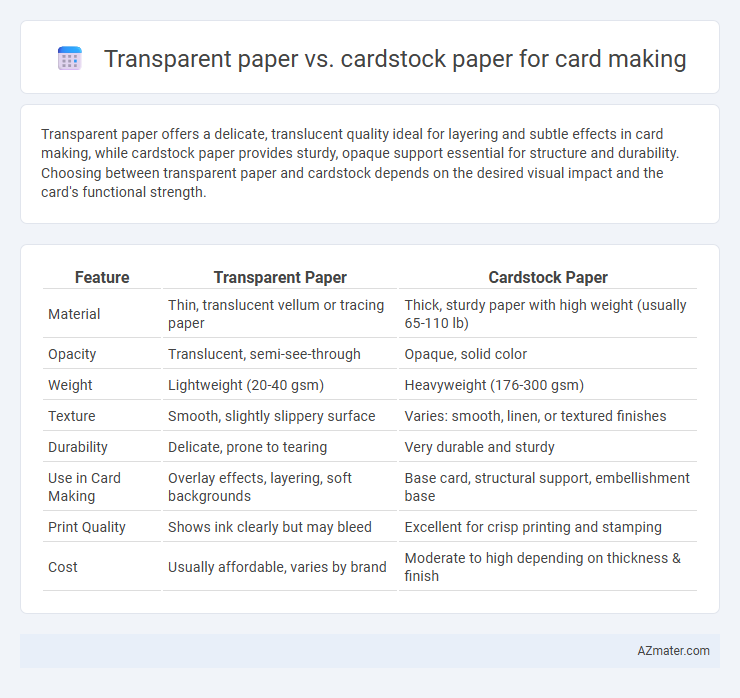Transparent paper offers a delicate, translucent quality ideal for layering and subtle effects in card making, while cardstock paper provides sturdy, opaque support essential for structure and durability. Choosing between transparent paper and cardstock depends on the desired visual impact and the card's functional strength.
Table of Comparison
| Feature | Transparent Paper | Cardstock Paper |
|---|---|---|
| Material | Thin, translucent vellum or tracing paper | Thick, sturdy paper with high weight (usually 65-110 lb) |
| Opacity | Translucent, semi-see-through | Opaque, solid color |
| Weight | Lightweight (20-40 gsm) | Heavyweight (176-300 gsm) |
| Texture | Smooth, slightly slippery surface | Varies: smooth, linen, or textured finishes |
| Durability | Delicate, prone to tearing | Very durable and sturdy |
| Use in Card Making | Overlay effects, layering, soft backgrounds | Base card, structural support, embellishment base |
| Print Quality | Shows ink clearly but may bleed | Excellent for crisp printing and stamping |
| Cost | Usually affordable, varies by brand | Moderate to high depending on thickness & finish |
Introduction to Card Making Papers
Card making papers vary widely, with transparent paper offering a delicate, see-through quality ideal for layering and adding subtle texture, while cardstock paper provides a sturdy, thick base essential for durable cards. Transparent papers, such as vellum or acetate, enhance design versatility with their light-transmitting properties, contrasting with cardstock's strong weight often measured in pounds or grams per square meter (GSM) for structural support. Understanding the unique characteristics of transparent paper versus cardstock is crucial for selecting the right material that suits the aesthetic and functional needs of handcrafted cards.
What is Transparent Paper?
Transparent paper, also known as vellum or tracing paper, is a lightweight, semi-translucent material made from cellulose fibers that allows light to pass through while diffusing the image beneath. It is commonly used in card making to add delicate overlays, soft backgrounds, or elegant layers without obscuring underlying designs. Compared to cardstock paper, transparent paper provides a subtle, ethereal effect, enhancing cards with texture and depth while maintaining visual clarity.
What is Cardstock Paper?
Cardstock paper is a thick, durable type of paper often used in card making due to its sturdy texture and ability to hold embellishments without bending or tearing. It typically ranges from 65 lb to 110 lb in weight, providing a solid base that supports detailed designs and layered decorations. Compared to transparent paper, cardstock offers more rigidity and opacity, making it ideal for creating strong, long-lasting cards.
Visual Effects: Transparency vs. Opaqueness
Transparent paper creates delicate, layered visual effects with its translucency, allowing light to pass through and revealing subtle overlapping designs for a soft, ethereal look. Cardstock paper, being opaque, provides solid, vibrant backgrounds that enhance bold, defined artwork and text, offering a sturdy base for embellishments. The choice between transparent and cardstock paper significantly impacts the overall aesthetic, with transparency adding depth and mystery, while opacity ensures clarity and vividness in card making.
Durability and Strength Comparison
Cardstock paper offers superior durability and strength compared to transparent paper, making it ideal for card making that requires a sturdy base. Its thicker composition resists bending and tearing, ensuring long-lasting cards. Transparent paper, while visually appealing for layering and decorative effects, lacks the robustness needed for structural support in cards.
Printing and Ink Compatibility
Transparent paper offers excellent ink adhesion for laser printing, producing sharp, vibrant images without smudging, but it may struggle with some inkjet inks due to slower drying times and potential bleeding. Cardstock paper, designed for heavy ink absorption, excels with both inkjet and laser printers, ensuring crisp, smudge-free prints and vibrant color saturation for card making. Choosing between transparent and cardstock paper depends on the specific printer type and ink technology used, with cardstock providing broader compatibility and reliability in most printing scenarios.
Creative Uses in Card Making
Transparent paper offers unique creative uses in card making by allowing light to pass through, enabling layering effects and subtle reveals of messages or designs beneath. Cardstock paper provides sturdy support for detailed embellishments, folding, and dimensional elements, making it ideal for creating durable, tactile cards. Combining transparent paper with cardstock enhances visual interest by merging translucency with structure, expanding artistic possibilities in handmade cards.
Layering and Embellishment Techniques
Transparent paper offers a delicate, translucent layering effect ideal for creating depth and subtle overlays in card making, allowing embellishments like glitter, foil, or embossed designs to shine through with a soft glow. Cardstock paper provides sturdy support for heavier embellishments such as buttons, ribbons, and layered die-cuts, maintaining structural integrity while showcasing bold textures and dimensional accents. Combining transparent paper with cardstock enhances visual interest, balancing lightweight transparency with the solid foundation necessary for diverse embellishment techniques.
Cost and Accessibility Analysis
Transparent paper offers a budget-friendly option for card making, with prices typically lower than cardstock, making it accessible for hobbyists and bulk projects. Cardstock paper, while generally more expensive per sheet, provides durability and a professional finish that justifies its cost for premium cards. Both materials are widely available online and in craft stores, though cardstock varieties come in more weight and texture options, impacting their price and accessibility.
Choosing the Right Paper for Your Card Project
Choosing the right paper for your card project depends on the desired texture, opacity, and durability. Transparent paper offers a delicate, translucent effect ideal for layering and subtle designs, while cardstock provides sturdiness and a smooth surface perfect for detailed printing and embellishments. Assess the card's purpose and aesthetic to determine whether transparency or strength best suits your creative vision.

Infographic: Transparent paper vs Cardstock paper for Card making
 azmater.com
azmater.com